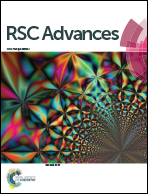Facile preparation of mesoporous Cu–Sn solid solutions as active catalysts for CO oxidation†
Abstract
With a facile co-precipitation method, a series of high surface area mesoporous CuxSn1−xOy solid solution catalysts have been synthesized and applied to CO oxidation. Compared with individual SnO2 and CuO, the activity of these catalysts is remarkably improved. The highest activity is achieved on Cu0.5Sn0.5Oy, a catalyst with a Cu/Sn molar ratio of 0.5/0.5 and a Caramel-Treats-like morphology. It is revealed by XRD, SEM-EDX mapping and HR-TEM results that Cu2+ cations have been incorporated into the crystal lattice of rutile SnO2 to form a uniform solid solution structure. As testified by N2 adsorption–desorption and SEM results, these CuxSn1−xOy catalysts contain well-defined mesopores and possess high surface areas and improved pore volumes, which are favourable for the dispersion of the active sites, the diffusion of the reactants and the easy interaction between the reactants and the catalyst surface. Moreover, H2-TPR and XPS results demonstrate that more active and loosely bounded oxygen species have been formed on the surface of these catalysts. It is believed that these are the predominant reasons leading to the superior CO oxidation activity over the CuxSn1−xOy catalysts. Notably, these CuxSn1−xOy catalysts are also resistant to water vapour deactivation, indicating they have the potential to be used in real exhaust control processes.


 Please wait while we load your content...
Please wait while we load your content...